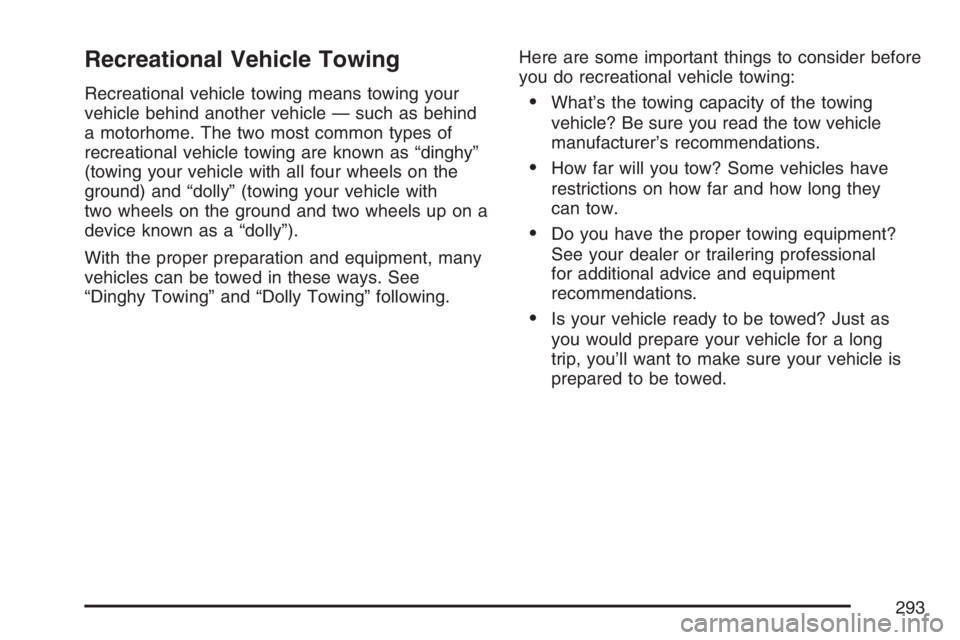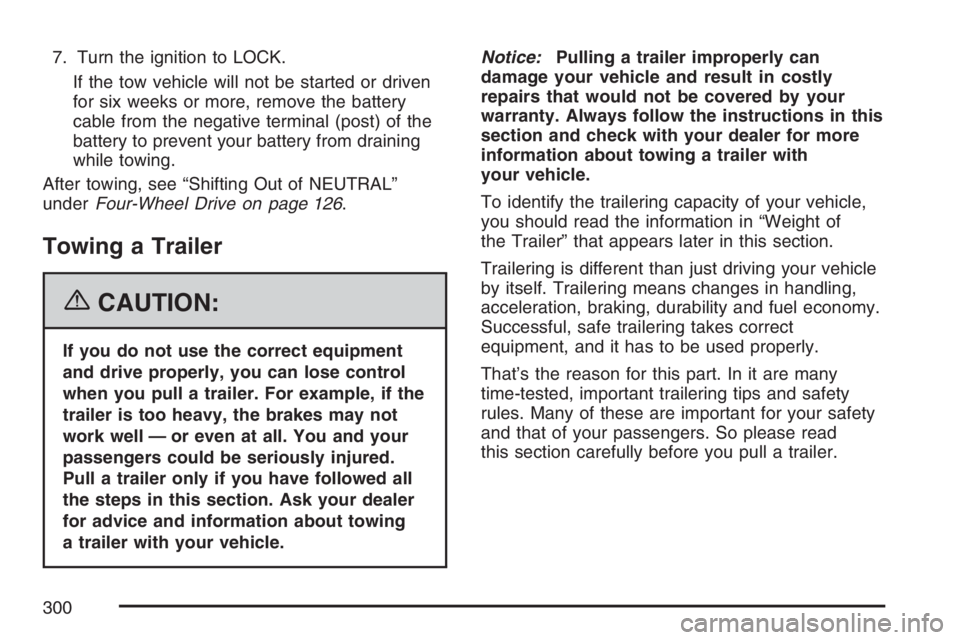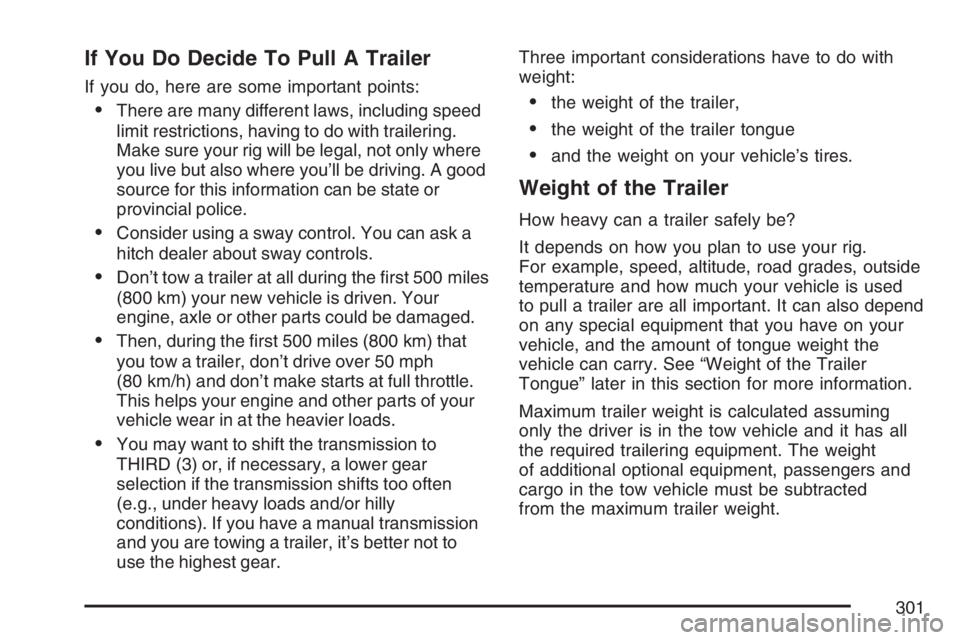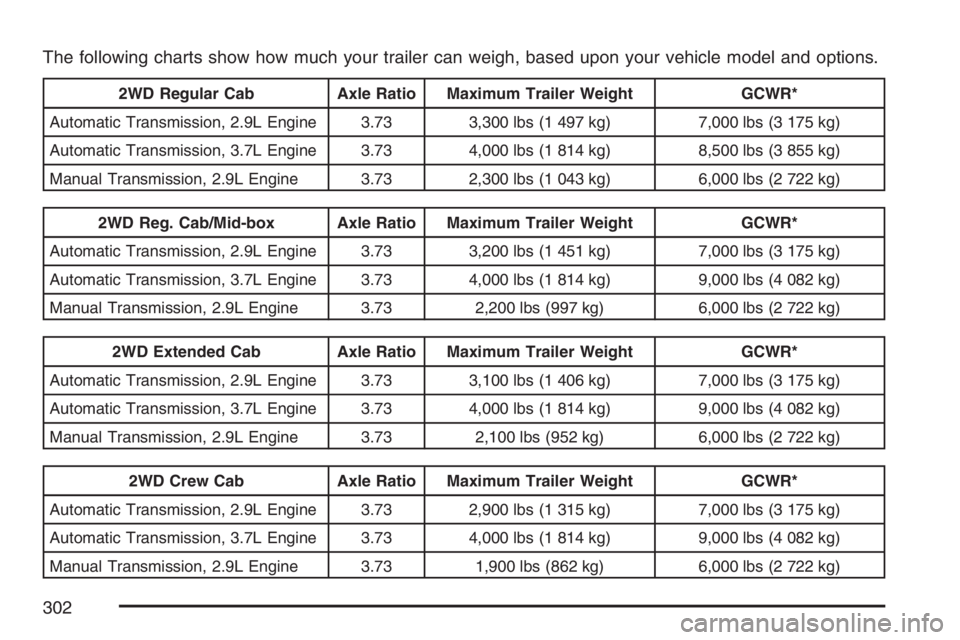2007 GMC CANYON trailer
[x] Cancel search: trailerPage 189 of 492

This light should come on, as a check to show
you it is working, when the ignition is on and the
engine is not running. If the light does not
come on, have it repaired. This light will also
come on during a malfunction in one of two ways:
Light Flashing— A mis�re condition has
been detected. A mis�re increases vehicle
emissions and may damage the emission
control system on your vehicle. Diagnosis and
service may be required.
Light On Steady— An emission control system
malfunction has been detected on your vehicle.
Diagnosis and service may be required.
If the Light is Flashing
The following may prevent more serious damage
to your vehicle:
Reducing vehicle speed
Avoiding hard accelerations
Avoiding steep uphill grades
If you are towing a trailer, reduce the amount
of cargo being hauled as soon as it is
possibleIf the light stops �ashing and remains on steady,
see “If the Light Is On Steady” following.
If the light continues to �ash, when it is safe to do
so, stop the vehicle. Find a safe place to park
your vehicle. Turn the key off, wait at least
10 seconds and restart the engine. If the light
remains on steady, see “If the Light Is On Steady”
following. If the light is still �ashing, follow the
previous steps, and see your dealer for service as
soon as possible.
If the Light Is On Steady
You may be able to correct the emission system
malfunction by considering the following:
Did you recently put fuel into your vehicle?
If so, reinstall the fuel cap, making sure to fully
install the cap. SeeFilling the Tank on page 320.
The diagnostic system can determine if the
fuel cap has been left off or improperly installed.
A loose or missing fuel cap will allow fuel to
evaporate into the atmosphere. A few driving trips
with the cap properly installed should turn the
light off.
189
Page 241 of 492

Your Driving, the Road, and Your Vehicle.... 242
Defensive Driving...................................... 242
Drunken Driving........................................ 243
Control of a Vehicle.................................. 246
Braking...................................................... 246
Anti-Lock Brake System (ABS).................. 247
Braking in Emergencies............................. 249
Traction Control System (TCS).................. 249
Limited-Slip Rear Axle............................... 250
Steering.................................................... 250
Off-Road Recovery.................................... 253
Passing..................................................... 253
Loss of Control.......................................... 255
Off-Road Driving........................................ 256
Driving at Night......................................... 270
Driving in Rain and on Wet Roads............ 271
City Driving............................................... 274Freeway Driving........................................ 275
Before Leaving on a Long Trip.................. 276
Highway Hypnosis..................................... 277
Hill and Mountain Roads........................... 278
Winter Driving........................................... 280
If Your Vehicle is Stuck in Sand,
Mud, Ice, or Snow ................................. 284
Rocking Your Vehicle to Get It Out........... 284
Recovery Hooks........................................ 285
Loading Your Vehicle................................ 286
Truck-Camper Loading Information............ 292
Pickup Conversion to Chassis Cab............ 292
Towing........................................................ 292
Towing Your Vehicle ................................. 292
Recreational Vehicle Towing...................... 293
Towing a Trailer........................................ 300
Trailer Recommendations.......................... 311
Section 4 Driving Your Vehicle
241
Page 287 of 492

The Tire and Loading Information label shows the
number of occupant seating positions (A), and the
maximum vehicle capacity weight (B) in kilograms
and pounds.
The Tire and Loading Information label also shows
the size of the original equipment tires (C) and
the recommended cold tire in�ation pressures (D).
For more information on tires and in�ation see
Tires on page 369andIn�ation - Tire Pressure
on page 377.
There is also important information on the
Certi�cation/Tire label. It tells you the Gross Vehicle
Weight Rating (GVWR) and the Gross Axle Weight
Rating (GAWR) for the front and rear axles. See
“Certi�cation/Tire Label” later in this section.
Steps for Determining Correct Load Limit
1. Locate the statement “The combined weight
of occupants and cargo should never exceed
XXX kg or XXX lbs” on your vehicle’s placard.
2. Determine the combined weight of the driver
and passengers that will be riding in your
vehicle.3. Subtract the combined weight of the driver
and passengers from XXX kg or XXX lbs.
4. The resulting �gure equals the available
amount of cargo and luggage load capacity.
For example, if the “XXX” amount equals
1400 lbs and there will be �ve 150 lb
passengers in your vehicle, the amount of
available cargo and luggage load capacity
is 650 lbs (1400−750 (5 x 150) = 650 lbs).
5. Determine the combined weight of luggage
and cargo being loaded on the vehicle. That
weight may not safely exceed the available
cargo and luggage load capacity calculated
in Step 4.
6. If your vehicle will be towing a trailer, the load
from your trailer will be transferred to your
vehicle. Consult this manual to determine how
this reduces the available cargo and luggage
load capacity of your vehicle.
SeeTowing a Trailer on page 300for important
information on towing a trailer, towing safety,
and trailering tips.
287
Page 289 of 492

Item Description Total
AVehicle Capacity
Weight for Example 3=1,000 lbs (453 kg)
BSubtract
Occupant Weight
200 lbs (91 kg) x 5 =1,000 lbs (453 kg)
CAvailable Cargo
Weight =0 lbs (0 kg)
Refer to your vehicle’s Tire and Loading Information
label for speci�c information about your vehicle’s
capacity weight and seating positions. The
combined weight of the driver, passengers, cargo,
and any accessories or equipment added to your
vehicle after it left the factory should never exceed
your vehicle’s capacity weight.
Certi�cation/Tire Label
A vehicle speci�c Certi�cation/Tire label is attached
to the bottom section of the center pillar, on the
driver’s side of the vehicle. Vehicles without a
center pillar, like extended cab models, will have
the Certi�cation/Tire label attached to the edge of
the driver’s side, extended cab door, below the door
latch post. The label shows the Gross Vehicle
Weight Rating (GVWR). The GVWR includes the
weight of the vehicle, all occupants, fuel, cargo, and
trailer tongue weight, if pulling a trailer.
Example 3
Label Example
289
Page 293 of 492

Recreational Vehicle Towing
Recreational vehicle towing means towing your
vehicle behind another vehicle — such as behind
a motorhome. The two most common types of
recreational vehicle towing are known as “dinghy”
(towing your vehicle with all four wheels on the
ground) and “dolly” (towing your vehicle with
two wheels on the ground and two wheels up on a
device known as a “dolly”).
With the proper preparation and equipment, many
vehicles can be towed in these ways. See
“Dinghy Towing” and “Dolly Towing” following.Here are some important things to consider before
you do recreational vehicle towing:What’s the towing capacity of the towing
vehicle? Be sure you read the tow vehicle
manufacturer’s recommendations.
How far will you tow? Some vehicles have
restrictions on how far and how long they
can tow.
Do you have the proper towing equipment?
See your dealer or trailering professional
for additional advice and equipment
recommendations.
Is your vehicle ready to be towed? Just as
you would prepare your vehicle for a long
trip, you’ll want to make sure your vehicle is
prepared to be towed.
293
Page 300 of 492

7. Turn the ignition to LOCK.
If the tow vehicle will not be started or driven
for six weeks or more, remove the battery
cable from the negative terminal (post) of the
battery to prevent your battery from draining
while towing.
After towing, see “Shifting Out of NEUTRAL”
underFour-Wheel Drive on page 126.
Towing a Trailer
{CAUTION:
If you do not use the correct equipment
and drive properly, you can lose control
when you pull a trailer. For example, if the
trailer is too heavy, the brakes may not
work well — or even at all. You and your
passengers could be seriously injured.
Pull a trailer only if you have followed all
the steps in this section. Ask your dealer
for advice and information about towing
a trailer with your vehicle.Notice:Pulling a trailer improperly can
damage your vehicle and result in costly
repairs that would not be covered by your
warranty. Always follow the instructions in this
section and check with your dealer for more
information about towing a trailer with
your vehicle.
To identify the trailering capacity of your vehicle,
you should read the information in “Weight of
the Trailer” that appears later in this section.
Trailering is different than just driving your vehicle
by itself. Trailering means changes in handling,
acceleration, braking, durability and fuel economy.
Successful, safe trailering takes correct
equipment, and it has to be used properly.
That’s the reason for this part. In it are many
time-tested, important trailering tips and safety
rules. Many of these are important for your safety
and that of your passengers. So please read
this section carefully before you pull a trailer.
300
Page 301 of 492

If You Do Decide To Pull A Trailer
If you do, here are some important points:
There are many different laws, including speed
limit restrictions, having to do with trailering.
Make sure your rig will be legal, not only where
you live but also where you’ll be driving. A good
source for this information can be state or
provincial police.
Consider using a sway control. You can ask a
hitch dealer about sway controls.
Don’t tow a trailer at all during the �rst 500 miles
(800 km) your new vehicle is driven. Your
engine, axle or other parts could be damaged.
Then, during the �rst 500 miles (800 km) that
you tow a trailer, don’t drive over 50 mph
(80 km/h) and don’t make starts at full throttle.
This helps your engine and other parts of your
vehicle wear in at the heavier loads.
You may want to shift the transmission to
THIRD (3) or, if necessary, a lower gear
selection if the transmission shifts too often
(e.g., under heavy loads and/or hilly
conditions). If you have a manual transmission
and you are towing a trailer, it’s better not to
use the highest gear.Three important considerations have to do with
weight:
the weight of the trailer,
the weight of the trailer tongue
and the weight on your vehicle’s tires.
Weight of the Trailer
How heavy can a trailer safely be?
It depends on how you plan to use your rig.
For example, speed, altitude, road grades, outside
temperature and how much your vehicle is used
to pull a trailer are all important. It can also depend
on any special equipment that you have on your
vehicle, and the amount of tongue weight the
vehicle can carry. See “Weight of the Trailer
Tongue” later in this section for more information.
Maximum trailer weight is calculated assuming
only the driver is in the tow vehicle and it has all
the required trailering equipment. The weight
of additional optional equipment, passengers and
cargo in the tow vehicle must be subtracted
from the maximum trailer weight.
301
Page 302 of 492

The following charts show how much your trailer can weigh, based upon your vehicle model and options.
2WD Regular Cab Axle Ratio Maximum Trailer Weight GCWR*
Automatic Transmission, 2.9L Engine 3.73 3,300 lbs (1 497 kg) 7,000 lbs (3 175 kg)
Automatic Transmission, 3.7L Engine 3.73 4,000 lbs (1 814 kg) 8,500 lbs (3 855 kg)
Manual Transmission, 2.9L Engine 3.73 2,300 lbs (1 043 kg) 6,000 lbs (2 722 kg)
2WD Reg. Cab/Mid-box Axle Ratio Maximum Trailer Weight GCWR*
Automatic Transmission, 2.9L Engine 3.73 3,200 lbs (1 451 kg) 7,000 lbs (3 175 kg)
Automatic Transmission, 3.7L Engine 3.73 4,000 lbs (1 814 kg) 9,000 lbs (4 082 kg)
Manual Transmission, 2.9L Engine 3.73 2,200 lbs (997 kg) 6,000 lbs (2 722 kg)
2WD Extended Cab Axle Ratio Maximum Trailer Weight GCWR*
Automatic Transmission, 2.9L Engine 3.73 3,100 lbs (1 406 kg) 7,000 lbs (3 175 kg)
Automatic Transmission, 3.7L Engine 3.73 4,000 lbs (1 814 kg) 9,000 lbs (4 082 kg)
Manual Transmission, 2.9L Engine 3.73 2,100 lbs (952 kg) 6,000 lbs (2 722 kg)
2WD Crew Cab Axle Ratio Maximum Trailer Weight GCWR*
Automatic Transmission, 2.9L Engine 3.73 2,900 lbs (1 315 kg) 7,000 lbs (3 175 kg)
Automatic Transmission, 3.7L Engine 3.73 4,000 lbs (1 814 kg) 9,000 lbs (4 082 kg)
Manual Transmission, 2.9L Engine 3.73 1,900 lbs (862 kg) 6,000 lbs (2 722 kg)
302